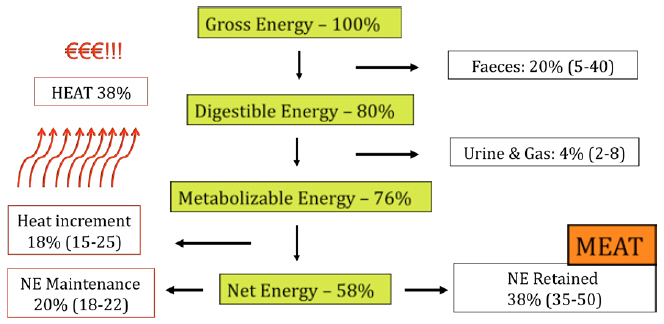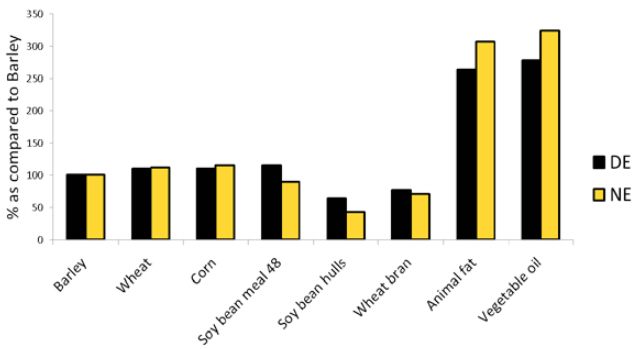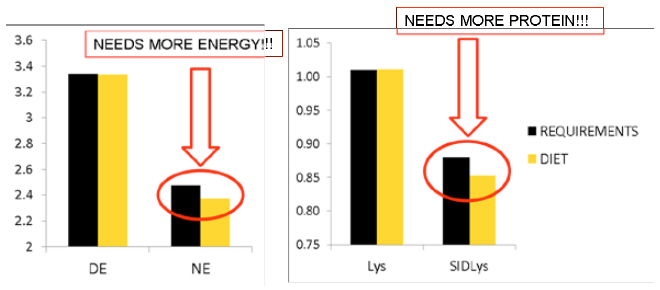



Benefits of Net Energy Utilisation for Pig Diet Formulation
At the 2014 Teagasc Pig Farmers' Conference, Edgar Garcia Manzanilla of Teagasc explained the different systems for expressing the energy content of feeds and feed ingredients for pigs and the advantages of using Net Energy for feed formulation.
When feeding any livestock species, our aim is to combine different ingredients available (e.g. cereals, soybean meal, oil) into a diet that covers the nutrient requirements of the animal, as accurately as possible.
The main nutrients present in the ingredients normally used in pig diets are:
- carbohydrates and fats, normally used as sources of energy.
- proteins and their forming units, the amino acids (e.g. lysine) as building blocks for muscle growth or milk/piglet production.
- vitamins and minerals as key elements in all the reactions that take place in an organism.
The system of units we use in order to combine the different ingredients to obtain the final balanced diet is called a feed formulation system. These systems differ mainly in the way they express the values for energy and protein.
The feed formulation system we use has very important effects on the profitability of our business as feed is the most important cost in any pig farm (more than 70 per cent of the production cost). At the same time, energy represents a major part of the cost of any pig diet. Thus, it is very important to pay attention to how energy is considered when formulating pig diets.
The amount of energy provided to the animal in the diet can be considered in different ways. Figure 1 shows the different ways that energy in the diet can be expressed.

The total amount of energy in the feed is called Gross Energy. It is measured by burning a sample of feed and measuring the amount of energy (heat) obtained. That is what the animal ctually does with a major part of the feed; it “burns” it to obtain energy. However, the animal is unable to use all the energy present in feeds and there are several losses when the nutrients are digested, absorbed and metabolised.
If we remove the energy lost in faeces, we have Digestible Energy and if then we remove the energy lost in urine and gas, we will be talking about Metabolisable Energy.
*
"Net energy is the only energy system that accounts for the real requirements of the animal."
In pigs, digestible and metabolisable energy are very similar and are around 75 to 80 per cent of the gross energy initially found in the diet. This percentage varies depending on the composition of the feed. Diets can be formulated based on the metabolisable or digestible energy of the ingredients as it is still done in many cases. However, the animal will be unable to use all that energy and we may be formulating a diet that is not balanced for the requirements of the pig. In other words, we could be giving the animal less energy than it requires or we could be providing the animal with energy that it actually does not need.
Other than faeces, urine and gas, there is also an important part of the energy from the feed that is lost as heat, and it can account for between 15 to 25 per cent of the energy present in the food. Once we subtract that additional loss of energy from the energy of the diet, we are talking about Net Energy; the real amount of energy that the pig will use to maintain itself and to grow, produce meat, or milk and piglets in the case of the sows. Thus net energy is the only energy system that accounts for the real requirements of the animal.
The differences in the energy content of different ingredients depending on the units used to measure energy are shown in Figure 2.

Taking into account that net energy is the real energy value of the ingredients, it can be easily seen in the figure that digestible energy overvalues the energy content of fibrous feedstuffs (like hulls or bran) or high-protein feedstuffs (like soybean meal). Thus, when we use a digestible or metabolisable energy system to formulate diets including these ingredients, we are providing an animal with an energy level that is not real and is actually lower than expected. On the other hand, we can also see in Figure 2 that fat and oil energy levels are under estimated by digestible energy systems.
Let’s illustrate what the problem could be when formulating a diet using digestible energy instead of net energy. We will consider a very simple diet only using barley, wheat, soybean meal and soya oil. If we formulate a balanced diet based on digestible energy as shown in Figure 3, we will need 67.6 per cent of cereals and 23.8 per cent of soybean meal. If we then look at the net energy of the diet, we will see that we are not meeting the real energy requirement of the pig. In this situation, the pig will have to consume more feed than expected in order to have all the energy it needs. However, it will be eating an extra amount of the whole diet in order to just get the energy. The rest of the diet will be wasted.
If we formulate the diet based on net energy, we would actually need 72.0 per cent of cereals and 23.3 per cent of soybean meal. If we calculate the price of this two ingredients in such diets with the current (September 2014) prices we would see that in Table 1.

Apparently, the diet based on digestible energy may seem cheaper. However, we should remember that the pig will be consuming more feed in order to reach its real energy requirement. In this case, the animal will eat five per cent more of this diet than the one based on net energy and the real price of the diet per pig would be:
- Diet based on ME: 214.81 × 1.05 = 225.55 €/tonne (i.e. 5.17€/tonne more)
The low energy will not be the only problem for the diet represented in Figure 3. It is also very important to consider the balance between energy and protein, in particular lysine as part of the protein. Lysine is another important nutrient in determining the price of the diet. If we go back to Figure 3, we will see that lysine, as energy, can be expressed in different ways. Figure 3 shows the values of total lysine and digestible lysine (normally referred as SID = standardised ileal digestibility). As in the case of gross energy, total lysine in the diet is not a good measure of the lysine available for the pig for growth because there are several losses before lysine is used for muscle growth. Digestible lysine is a better guide of its nutrient value.
In Figure 3, the diet is formulated using total lysine and we can also see how digestible lysine in the diet is not enough to cover the requirements of the pig. This problem will not be solved by the use of the net energy system. To solve it, we could increase the amount of soybean meal in the diet in order to raise the amount of lysine. However, we would be wasting everything else that is not lysine in the soy. Instead, the use of synthetic amino acids will allow us a more precise diet formulation with cheaper final prices despite the high cost of the synthetic amino acids.

Synthetic amino acids can be used even if net energy system is not used. However, net energy formulation places a higher value on synthetic amino acids than when formulating on a digestible energy basis. Soybean meal is not a good energy source and the DE system gives soybean meal an inflated energy value. Net energy gives a more realistic measure of the energy available in soya. Thus reducing soybean meal and using synthetic amino acids with a higher level of cereal will be a better option.
A question that immediately comes to mind is why are not all companies/countries using net energy and synthetic lysine when formulating their diets?
The reason is basically the initial effort that it requires in order to adjust the system to a particular situation compared to the potential benefit. Using the net energy system requires some work in order to obtain the real net energy values of the ingredients and how they related to the final composition of the carcass.
For this matter, two main options are available, the French system (INRA) and the Dutch system (CVB). There are differences between the Dutch and the French systems but these are modest. The most important disagreement between the two is in estimated energy value of fat sources. Countries like France, Denmark and the Netherlands adopted net energy systems as soon as they saw the benefits. It took a little bit more time in the US because the benefits are less when diets are based on corn and soya at low prices.
In summary, the net energy system allows for more complex diets with an increased use of by-product feeds, such as distiller's grains and with substantial use of synthetic amino acids, resulting in lowering of dietary crude protein. With these diets, the net energy system comes into its own and offers substantial benefits to the producer. However, it will offer potential benefits of €1 to €2 per pig by just using it for the ingredients currently used in Ireland.
Reference
Manzanilla E.G. 2014. Benefits of net energy utilisation for pig diet formulation. Proceedings of the Teagasc Pig Farmers' Conference 2014. 21 and 22 October 2014. p18-21.
Further Reading
You can view other papers from the 2014 Teagasc Pig Farmers Conference by clicking here.
December 2014






